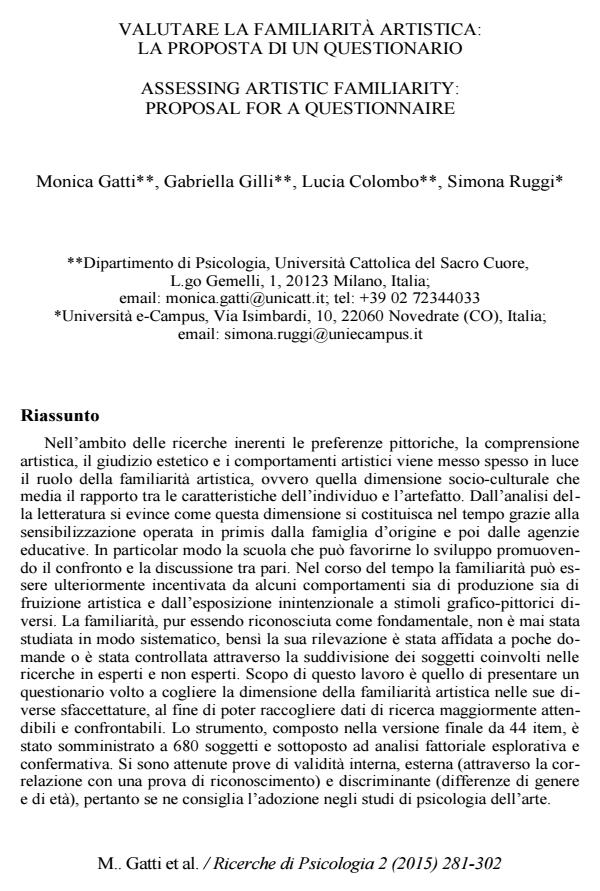Assessing artistic familiarity: proposal for a questionnaire
Journal title RICERCHE DI PSICOLOGIA
Author/s Monica Gatti, Gabriella Gilli, Lucia Colombo, Simona Ruggi
Publishing Year 2015 Issue 2015/2
Language Italian Pages 22 P. 281-302 File size 203 KB
DOI 10.3280/RIP2015-002001
DOI is like a bar code for intellectual property: to have more infomation
click here
Below, you can see the article first page
If you want to buy this article in PDF format, you can do it, following the instructions to buy download credits

FrancoAngeli is member of Publishers International Linking Association, Inc (PILA), a not-for-profit association which run the CrossRef service enabling links to and from online scholarly content.
Studies on pictorial preferences, artistic comprehension, aesthetic judgment and artistic behaviors often highlight the role of artistic familiarity, i.e. the socio- cultural dimension that mediates the relationship between the individual’s features and the artworks. Literature shows how the origin of the artistic familiarity is linked to the stimulation coming from the family and the educational agencies. Particularly, school could promote its development by encouraging debate and discussion among peers. Over time the familiarity can be further fostered by some artistic behaviors (both production and fruition) and by the unintentional exposure to artistic stimuli. Familiarity, although recognized as fundamental, has never been systematically explored, but its recognition was relegated to a few questions, or was controlled through the partition of experimental subjects in "experts" or "non-experts". The aim of this work is to present a questionnaire designed to assess the artistic familiarity in all its aspects, in order to collect more reliable and comparable research data. The questionnaire, in its final version consisting of 44 items, was administered to 680 subjects and subjected to exploratory and confirmatory factor analysis. It shows evidence for internal validity, external validity (through the correlation with a recognition test) and discriminant validity (differences in gender and age). Therefore we recommend its adoption in studies pertaining to the psychology of art.
Keywords: Artistic familiarity, questionnaire, validity analysis.
Monica Gatti, Gabriella Gilli, Lucia Colombo, Simona Ruggi, Valutare la familiarita artistica: la proposta di un questionario in "RICERCHE DI PSICOLOGIA " 2/2015, pp 281-302, DOI: 10.3280/RIP2015-002001